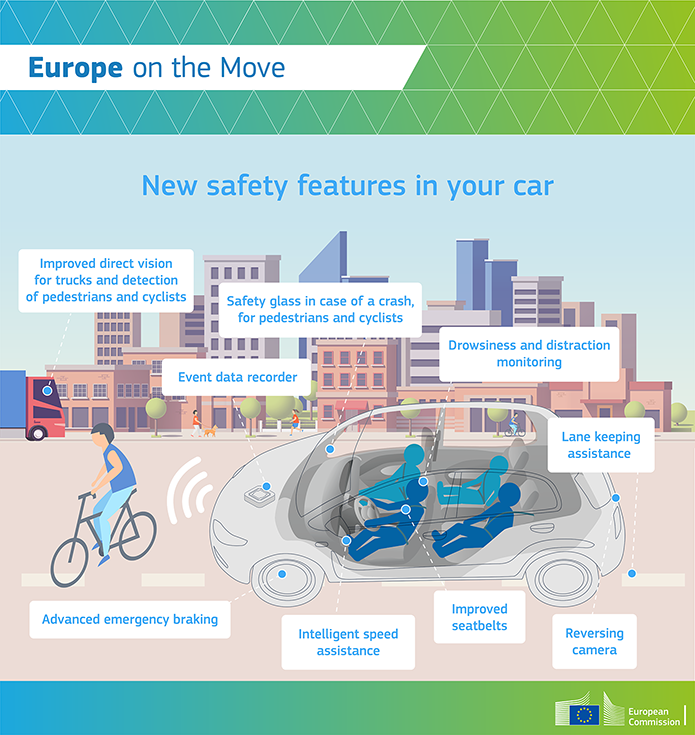SSZT486 May 2019 AWR1843 , LM5146-Q1 , LM53625-Q1 , LM61460-Q1 , LM65645-Q1 , LM70660 , LM706A0 , LM706A0-Q1 , LM70840 , LM70840-Q1 , LM70860 , LM70860-Q1 , LM70880 , LM70880-Q1 , LM73606-Q1 , LM76003-Q1 , LMS3655-Q1 , LP87322F-Q1 , LP87332A-Q1 , LP87564-Q1 , LP87702-Q1 , TPS54618-Q1
From trade shows to TV commercials, by now we’ve all been exposed to the cutting-edge advanced driver assistance systems (ADAS) that are available in automobiles. While many automakers only offer these features in their luxury models today, mandates driven by the European Commission’s Safe Mobility initiative will bring them to the masses – in all new cars produced from 2021 onward (see Figure 1).
 Figure 1 Features Mandated by European
Commission Regulations*
Figure 1 Features Mandated by European
Commission Regulations*The systems that enable these features have unique power requirements, and TI’s DC/DC converter portfolio has a wide variety of solutions with which to meet them. Today, we’ll focus on three of those systems.
What Does the European Commission Require?
Advanced emergency braking and intelligent speed assistance.
What system enables these requirements? Medium range radar.
Advanced emergency braking and intelligent speed assistance, also known as adaptive cruise control, make highway driving easier and safer. By using highly precise radar transceivers such as TI’s AWR1843, vehicles can sense other vehicles and passing obstacles and slow down accordingly. These sensors have strict ripple requirements that make selecting a low-noise power solution critical. The LM53625-Q1 is a strong choice for off-battery regulation – its novel symmetrical flip-chip package minimizes both ringing and emissions. For secondary regulation, there are several options to choose from based on the amount and type of output filtering required. Among these, the LP87702-Q1 has a good balance between cost and performance by requiring only one external linear regulator to meet ripple requirements.
What Does the European Commission Require?
Improved direct vision for trucks for the detection of pedestrians and cyclists.
What System Enables These Requirements?
Front camera systems use one or more cameras mounted on the windshield to capture video data of the road ahead and identify potential hazards such as pedestrians and cyclists. The European Commission is currently only mandating these systems for larger vehicles like trucks and buses, which are notable for their 24-V nominal battery voltage. Front camera systems are one of the more power-hungry driver assistance systems due to the sheer density of data they have to process. The LM76003-Q1 is a strong converter option because its wide 60-V input range can withstand load-dump conditions, and it can supply up to 3.5 A in a small quad flat no-lead (QFN) package.
While the European Commission is not currently mandating direct vision functionality for cars, the LM73606-Q1 can enable a scalable solution from 12-V systems to 24-V systems, since it’s in the same package as the LM76003-Q1. For even greater power requirements, TI makes a scalable external FET controller, the LM5146-Q1. Managing thermal dissipation at the point of load is equally important; for this reason, it’s common to use a two-chip solution with a high-current buck like the TPS54618-Q1 for the core rail and a flexible power-management integrated circuit (PMIC) like the LP87564-Q1 for everything else.
What Does the European Commission Require?
Drowsiness and distraction monitoring.
What System Enables These Requirements?
Medium range radar, front camera, and driver monitoring systems will become much more common in new vehicles to satisfy the EU Commission’s Safe Mobility mandates. While each of these systems has a unique power architecture and a unique set of development challenges, TI’s broad portfolio of controllers, converters, and PMICs has optimized solutions for each of them.
Additional Resources
- Read the European Commission press release, “Europe on the Move: Commission completes its agenda for safe, clean and connected mobility.”
- Learn more about “Choosing the right DC/DC solution for automotive front camera systems.”
- Read the blog post, “How driver monitoring systems can help with collision avoidance, part 1.”